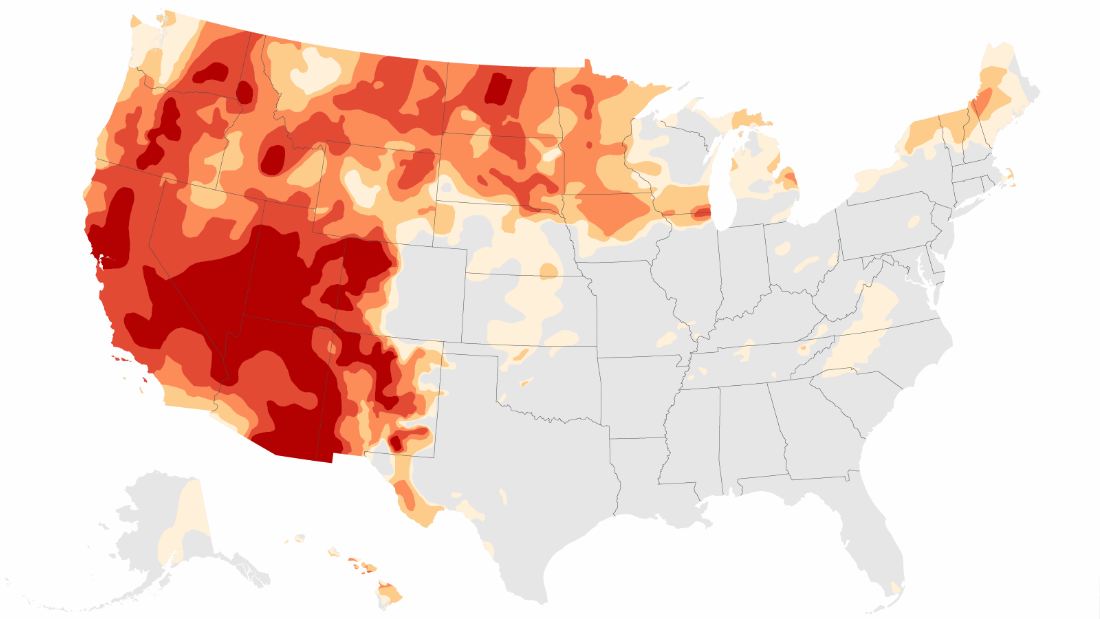These visuals show just how bad the US drought really is
Despite some good rainfall in Southwest, new drought numbers show worsening and expanding drought across the board in the West, according to the US Drought Monitor. More than 95 percent of the West is in some level of drought, with nearly two-thirds in extreme or exceptional drought — the two worst categories.
Six states are entirely in drought conditions.
Across the US, the drought has nearly doubled in size from this time last year. Around 25% of the country was in drought conditions in July 2020; as of this week, nearly half is in drought.
Climate change is playing a key role in these compounding crises: Drought and extreme heat are fueling wildfires; reduced snowpack and the lack of substantial precipitation are exacerbating water demands for millions of people, as well as agriculture, ecosystems and deteriorating infrastructure.
Current drought
More than 95% of the West is in drought, the largest area on record. More than 65% of the region is in ‘extreme’ or ‘exceptional’ drought — the two most severe categories — expanding by 60,000 square miles, or about the size of the state of Georgia, during the month of July.
There are six states completely in drought conditions: California, Oregon, Nevada, Utah, Idaho and North Dakota.
While showers from the Southwest monsoon improved conditions in Arizona, New Mexico, and southwestern Colorado, it brought little relief. Elsewhere, drought intensified across the northern Rockies and especially the Pacific Northwest where the numbers are dire and the rainfall has been basically nonexistent.
Many of the West’s largest reservoirs and lakes continued to show shocking declines. Lake Mead, a Colorado River reservoir behind the Hoover Dam, fell 135 feet below its 2000 level, when it was last considered full.
Meanwhile, the Flaming Gorge Reservoir in Wyoming and Utah is releasing water to boost Lake Powell’s water levels to protect its hydropower generating capacity. Also in Utah, the surface elevation of the Great Salt Lake also declined, tying the previous record low set in 1963.
As the planet warms, drought and extreme heat will also fuel deadly wildfires. Multiple studies have linked rising carbon dioxide emissions and high temperatures to increased acreage of burning across the West, particularly in California.
Rainfall outlook
The West experienced extremely low rain and snowfall over the past year, compounded by drastically high temperatures. Less rain and increasing heat waves have led directly to drought conditions and water shortages.
The Southwest monsoon, which began in mid-July, is expected to lead to some relief in that region. Still, the Drought Monitor reports recent rain “provided limited drought relief.” In some cases, the agency reports, “moisture has seeped several feet into the soils.”
As climate change accelerates and winter temperatures increase, snowfall will decrease. High-elevation snowpack serves as a natural reservoir that eases drought, storing water through the winter months and slowly releasing it through the spring melting season.
Stream and river flow
Streamflow, a measure of how much water is carried by rivers and streams, is another significant indicator of drought and its impact.
As drought conditions have worsened in 2021, hundreds of stream and river locations are experiencing below-average flow. More than 50 percent of the western monitoring stations reported lighter-than-usual flows. Fishing restrictions have also been put in place on many rivers in Montana due to low flows and warm waters.
Changes in streamflow affect the water supply for our own municipal use, crop irrigation and power generation.
![]()


